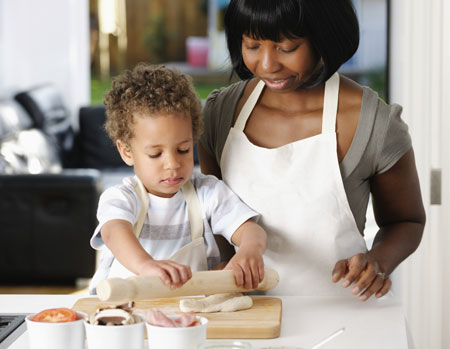Cooking is a wonderful way to engage children and provide rich learning opportunities. Cooking engages the senses and gives children hands-on opportunities to explore food. Children enjoy discovering the smells, textures, and tastes of different foods. Cooking experiences are a wonderful opportunity to work the small muscles of their hands by using simple kitchen tools and to develop hand-eye coordination as they are sprinkling, pinching, squeezing, and organizing ingredients.
Baking cookies is often what comes to mind when many early childhood educators and parents think of cooking experiences for young children. Children are excited to pour ingredients, stir them in a bowl, scoop the dough onto trays, and see raw ingredients change into finished cookies after a trip to the oven.
Baking provides many wonderful opportunities to measure, mix, observe, and predict what will happen with ingredients. Curious young learners will be interested to learn about the source of ingredients such as flour. You can describe how wheat is grown in a field, is harvested by a combine, and is processed in a mill. Read stories such as The Little Red Hen and find informational books with photographs of the production of flour to expand upon your cooking conversations.
Of course, a baking activity with young children might seem like an overwhelming task that has potential to create a big mess. Your classroom or home setup may not make it easy to bake with young children. Many cooking activities require less setup and preparation, but they are still meaningful learning opportunities. These simple cooking experiences can help you build your confidence about cooking with young children. These activities also allow you to have these rich learning experiences even when space or resources are more limited.
Here are some cooking ideas that can give children experiences that help them develop the skills and knowledge described in the Illinois Early Learning and Development Standards (IELDS). Cooking with young children can provide lots of opportunities to address several IELDS benchmarks.
- Make a sandwich together. As you gather the ingredients, encourage children to look at the labels on the items. You can encourage your child to look for letters and words she knows. Talk about the order you need to follow when putting the sandwich together. What food needs to be put on the sandwich first and what food is last.
- Slice soft fruits or vegetables for a salad using a butter knife. Count the pieces of fruit you have cut and talk about their shapes. Compare the quantities of items in your salad. For example, ask children “Does the salad have more tomato or cucumber slices?”
- Squeeze lemons for lemonade or oranges to make fresh orange juice. As you create your beverage, you can talk about the trees where the fruit was grown, who harvests and transports the fruit to the store, and the parts of the fruit such as the peel, pith, and pulp.
- Spread cream cheese, nut butter, or hummus on toast or crackers. Introduce vocabulary such as thin and thick as the children use a dull knife to put the spread on the crackers or toast. To encourage math thinking, you can ask children how many crackers are needed to make three sandwiches or to guess the number of crackers on their plates.
- Crack and whip eggs for scrambled eggs. Talk about how a chicken lays eggs. Name the different parts of the egg (shell, yolk, white). Supervise children carefully by the stove so they can watch the cooking, and talk about how the eggs change as they are heated in the pan.
Perhaps your next meal or snack can become a learning adventure for the children in your care.

Rebecca Swartz
Dr. Rebecca Swartz is an assistant professor in the Department of Teaching and Learning at Southern Illinois University Edwardsville. She teaches courses in the early childhood education program including courses on early language and literacy, early mathematics, and collaboration with families. Prior to coming to SIUE she was an early learning specialist on state early childhood projects in the Department of Special Education at the University of Illinois at Urbana-Champaign.
Biography current as of 2022


